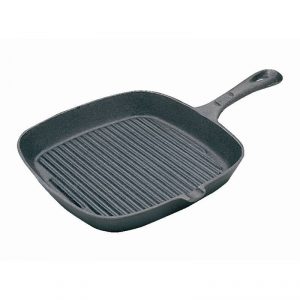
Cast iron cookware offers an incredibly durable piece of equipment that evenly conducts heat throughout. Although cast iron products are primarily designed for use on a stove top, they can also be used in the oven and over an open fire, giving them a great deal of versatility. Cast iron also features on many pieces of cooking equipment such as griddles, chargrill grids and contact grills.
You may be thinking that cast iron cookware and equipment is the obvious choice for your kitchen thanks to the even heat distribution that it offers.
However, you must be aware that cast iron involves more maintenance than other alternatives in order to prevent rusting.
The method of protection required is known as 'seasoning' and the process must be carried out before use and again after cleaning.
Seasoning Cast Iron
- A natural oil, such as vegetable oil, should be lightly coated over the pan.
- Your oven should be preheated to 148˚C/300˚F.
- Place a piece of foil at the bottom of the oven cavity and place the pan upside down on the wire rack above. Any excess oil will drip onto the foil reducing mess and ensuring that the pan cannot be over oiled.
- Leave the pan in the oven to bake for approximately 45 minutes.
- The seasoning process is complete.
To make the most out of your cast iron cookware you should always follow the recommended cooking processes.
In the case of pans, they must typically be preheated before use so that it is warm but not hot.
To guarantee that your pan is the right temperature, try sprinkling a little water into the cookware; if the water evaporates, the pan is too hot. If the water bubbles then your pan has reached the perfect temperature.
Following this simple rule will reduce the amount of cleaning that needs to be carried out after use.
Cleaning Cast Iron
Grill Plates & Grids
- Use a rake tool to scrape grill plates or branding irons, removing any food deposits or residue. Use a smooth back and forth motion without scrubbing. Work along the entire grid.
- Turn all burners on to full power for around 10 minutes. This heats the grids and burns off any residual food debris.
- After 10 minutes turn off all heat and allow to cool for approximately 30 minutes.
- Remove the grids whilst wearing hot use gloves.
- Wash grids using the following method that is also used for cookware.
Cookware
Do's
- Use warm water and a mild washing detergent to clean your cookware. It is important that you allow the pans to completely cool before cleaning, reducing risk of injury to washing staff.
- Only use soft cloths or sponges to clean cast iron surfaces. Any abrasive and harsh scouring will result in scratches and therefore areas of potential rust.
- Rinse with cold water - the effect from hot and cold can help to kill any remaining bacteria.
- Drying of the item must be carried out immediately after washing and should be done thoroughly. There should be no element of dampness when the cookware is stored.
- Season after cleaning if required.
Don’ts
- Don’t be tempted to run your cast iron items through the dishwasher, no matter how busy the kitchen is.
- Never use abrasives to clean cast iron cookware as the risk of rusting will be greatly increased if scratches or blemishes are present.
- Soaking a pan may seem like a good idea if there are areas that have stubborn stains however this will further increase the chance of your cookware being susceptible to rust.
- Never store food even for short periods, in seasoned cast iron pots; any acidity from the food will decrease the effectiveness of the seasoning over time and your ingredients will also be left with a metallic taste which is not desirable.
Implementing the correct methods of caring for your cast iron will ensure that your kitchen extends the lifespan of cast iron equipment and cookware and is always equipped to deliver high quality results.


